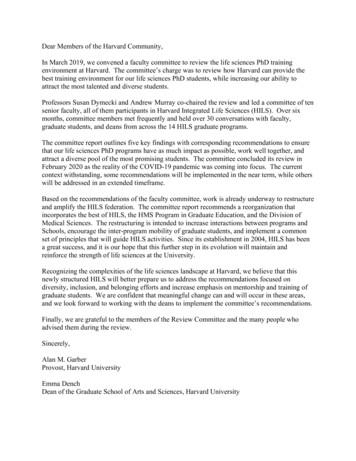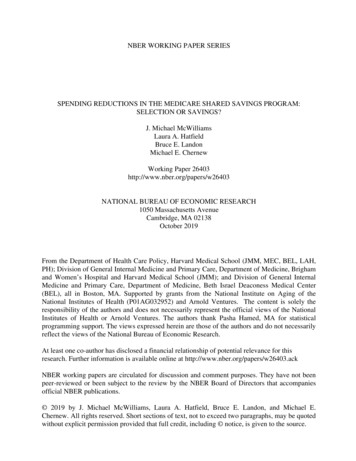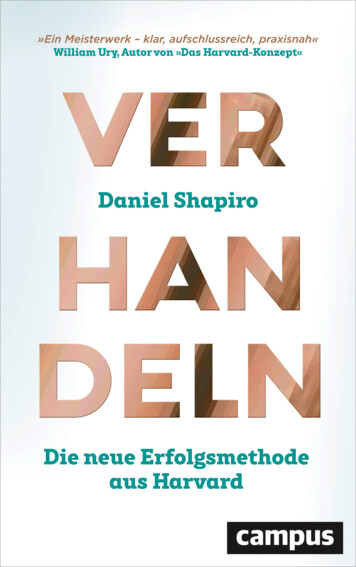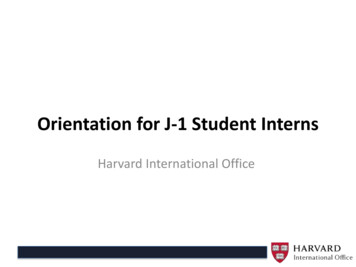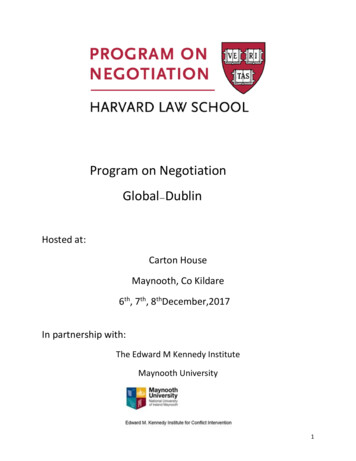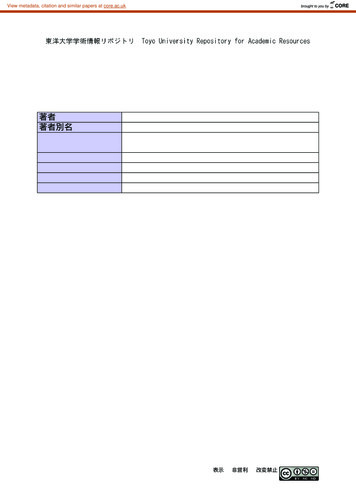
Transcription
View metadata, citation and similar papers at core.ac.ukbrought to you byUsing Harvard PON in a Business NegotiationCourse著者著者別名journal orpublication titlevolumepage rangeyearURLCara PHILLIPSCara PHILLIPSJournal of business .jp/1060/00011539/Creative Commons : 表示 ‑ 非営利 ‑ ‑nc‑nd/3.0/deed.jaCORE
119Using Harvard PONin a Business Negotiation CourseCara PhillipsAbstractThis study is an investigation into using the Harvard LawSchool: Program on Negotiation (PON) in a business negotiationcourse at Toyo University for intermediate to advanced Englishlearners of various nationalities. The students were surveyed atthe end of the course about different aspects of the PON’ssimulations, such as the level of difficulty of the simulations andenjoyability of the activities and topics. Their views yieldedmainly positive results, but details in the students’ answers andcomments provide valuable insight into content-basedinstruction (CBI). While researchers and instructors have seenmany benefits to CBI, it is important to factor in the students’own impressions of the course content and methods. The goal isfor students to feel that their knowledge and skills in both theEnglish language and the academic subject matter haveimproved from said instruction.1. Introduction1.1 Content-Based Instruction (CBI)Content-based instruction (CBI) focuses on a subject matterand is taught in the target language; the latter is generally notthe focus. Students are, nonetheless, ableto “develop theirlinguistic ability in the target language,” as one does during firstlanguage acquisition (Peachey, 2020). Given the “meaningfulcontext” in CBI, “authentic materials are often used and thefocus is on the whole discourse rather than on isolated sentences”(Tseng & Chen 2015, p.37). As early as 1985, Krashen assertedin his Input Hypothesis that for advanced learners, ESL/EFLcourses are far less effective in second language acquisition thansubject matter courses. He also went on to explain that thesuccess of immersion and bilingual programs was due to thecomprehensible input factor – an advantage they had overregular language classes.Content-based instruction (CBI) and content-based languageteaching (CBLT) are types of English for Specific Purposes
120(ESP). There are various categories of CBI, as well, such as:theme-based instruction, sheltered instruction, and adjunctinstruction. Theme-based is a model of language-basedinstruction centered on themes as the content. Shelteredinstruction refers to a model in which students of non-nativelevel proficiency are separated from native-level students andput in a class with special language assistance to help thembetter understand the mainstream course content. Adjunctinstruction refers to a more balanced approach to content andlanguage instruction (Brinton, 2007).Some advantages of content-based instruction are that themain subject matter could further learners’ knowledge and skillsrelated to their majors or academic subjects. Furthermore, thecontent relevant to their majors would be more interesting andmotivating compared to isolated language learning. However,some disadvantages, (primarily for students of lower Englishproficiency), may include a feeling that their language skills arenot improving through the content instruction. Both input andoutput in said subject matter using the target language couldalso be too challenging for students of lower proficiency. Apossible solution to both of these potential problems is to“include[e] some form of language focused follow-up exercises tohelp draw attention to linguistic features within the materialsand consolidate any difficult vocabulary or grammar points” andto provide some extra language assistance or explanation ormaterials in the students’ native language to supplement thematerials in the target language (Peachey, 2020).The effectiveness of content-based instruction at theuniversity level is well-documented. Amiri and Fatemi (2014)found in their study at an Iranian university that “studentstaught through the CBI method outperformed their counterpartgroup which was taught via the GTM [grammar translationmethod]” (p. 2163). In addition, through student evaluations,“the obtained results revealed that the students’ LLO [languagelearning orientation] and motivation have changed to someextent in the CBI group, [and] it can be inferred that the CBIhas been more effective in comparison to the GTM” (Amiri &Fatemi, 2014, p. 2163). At a Taiwanese university, in a CBI
121course called “International and Business Etiquette”, Tseng andChen (2015, p. 48) found that:Students perceived positively and were benefited greatly inlearning both content and language in this CBI adjunctcourse attributed to the following factors: (1) the integratedtasks which interweave all language skills, (2) teachers’ andpeers’ comprehensible input via structured activities, (3)meaningful context for comprehensible output, (4) clearguidance for self and peer evaluation, and (5) purposefultasks which enhance cooperative learning.Specifically regarding CBI and business negotiation, Xi wrote ofhis research on Chinese university business education: “teachersshould let the student visually realize the business negotiationskills and negotiation and marketing expertise that they need tomaster in their simulation training and role-playing” (2018,p.12).1.2 Harvard Law School: Program on Negotiation (PON)The Program on Negotiation (PON) has been offered atHarvard's Cambridge campus for the past 30 years. Non-nativeparticipants should have a suggested “TOEFL written examscore of 570 as a minimum proficiency standard”, which is ahigh B2 CEFR equivalent (ETS, 2020). Through PON,Continuing Legal Education (CLE) credits are attainable forlawyers who have passed the Bar. However participants “do notneed any previous training in American law.Participants froma wide variety of professions have found these programsinvaluable” (Harvard, 2020a).There is also PON Global, which is an intensive 3-dayworkshop offered in various cities around the world. Theworkshop has both an onsite instructor and video instruction byPON faculty. “In addition, participants are linked to professorsat Harvard and can ask questions about their own negotiationchallenges.” The interactive sessions using “real-life Harvardcase studies” provide opportunities for negotiation exercises anddiscussion. At the end, participants receive a PON GlobalCertificate from Harvard Law School (Harvard, 2020b).Countless negotiation simulations and other materials usedin both the Harvard Cambridge campus and Global PONprograms are available to educators for free download at
122pon.harvard.edu. There is also a PON email newsletter called“The Negotiation Insider” with featured negotiation topics thatcould help guide and inspire teachers in creating lesson plans(Harvard, 2020c).2. Procedure2.1 The CourseBusiness Negotiation is an undergraduate elective courseoffered both spring and fall terms at Toyo University. Whilemost students only take one semester, it is possible to take a fullyear of the course. Therefore, the spring and fall semestercourses focus on different areas of negotiation. The formercourse deals with the phases of negotiation: preparation,process/bargaining, and closing; distributive negotiationstrategy: BATNA, aspiration base, and the power of fairness;and integration negotiation strategy: a relationship of trust andmutual gain, providing information, and questioning. The lattercourse deals with the negotiation styles of competing,collaborating, avoiding, accommodating, and compromisingstyles and proceeds with the negotiation tactics of nibbling, theuse of higher authority, walk-away power, the power oflegitimacy, and effective body language.Simulations are chosen from the PON website – in theteaching material section – for students to practice eachnegotiation tactic, style, and tactic mentioned above. They areselected based on the lesson topic or aspect of negotiation to belearned and practiced, and on difficulty level and length. Someare shortened to be a more manageable length for student’sreading time and in order to eliminate unnecessary or repetitiveinformation. However, the language in the simulation wasintentionally not altered to maintain its authenticity.The course is meant to be a class taught in English, but notan English course. Given that the majority of students who signup for the course are non-native speakers of English, it can beviewed as a content-based course for students of intermediate tohigh English proficiency, and therefore, explicit languageteaching is not the goal. The instructor chose the most easilycomprehensible simulation one could find that fit each lessonobjective. This provided plenty of opportunity for students to askquestions and get individual assistance should they struggle to
123understand the lectures, discussions, negotiation practice orreadings /simulations.2.2 ParticipantsThe 13 participants were students in the fall 2018 course, somost of them had only learned the fall course styles and tactics,not the spring course topics. All students were assured theirresponses to the survey would not affect their grades and wereencouraged to answer clearly and honestly.The participants were from diverse backgrounds. Their majordepartments are varied, including Business Administration,Law, Economics, Literature, and International Tourism. Therewere also several different nationalities represented – mostlyfrom Asian countries: five from Japan, one from Japan and Iran,three from Malaysia, one from Taiwan, one from Korea, onefrom China and one from Mexico. The benefit is real-life culturalimmersion and fewer chances of native language use withclassmates.In order for students to succeed in the course, it isrecommended – but not required – that they have CommonEuropean Framework of Reference for Languages (CEFR) B1 orhigher, meaning “independent user” or “proficient user” ofEnglish. Since most undergraduate students have not achievedthis level of English proficiency, the student numbers for thiscourse tend to be small. Nonetheless, despite the recommendedminimum CEFR level of B1, some students who joined thecourse were in the A2 and even A1 range, which can bedescribed in CEFR as “basic users” (ETS, eScaleRangeMinimum ScoreA1A2B1B2C1C2Basic 0490NA5–49560115275385455NA
1242.3 The Survey Given to ParticipantsThe survey questions were meant to gauge the participants’views on the Harvard Law School Program on Negotiation(PON) simulations with regard to enjoyability, difficulty,usefulness, how interesting they were and whether or notparticipants feel their understanding and skills related tonegotiation improved (see appendix for original survey). Possibleanswers for questions 1-3 followed a 5-point Likert scale andquestions 4-5 were open-ended:1. Did you enjoy enacting the various PON simulations(readings/scenarios)?2. How did you feel about the level of difficulty of the variousPON simulations (readings/scenarios)?3. How did you feel about the topics of the various PONsimulations (readings/scenarios), in terms of usefulnessand level of interest?4. Did you think enacting the various PON simulationshelped you understand negotiation better and/or honeyour negotiation skills better?5. What other impressions or advice did you have about thesimulations or for using PON in future negotiationcourses?3. Survey ResultsFigure I. below shows the participants’ mean ratings forenjoyability, difficulty level, and usefulness/interest in the PONsimulations as 1.77, 2.15 and 1.54 respectively.With regard to participants’ CEFR level, participants’ meanrating for enjoyability is lowest at 2.5 for the lowest level, A2,otherwise there does not seem to be a clear correlation betweenCEFR level and enjoyability rating. The same is true for theparticipants’ rating of usefulness and level of interest, with theA2 participants scoring it the lowest at 1.75, otherwise theredoes not seem to be a clear correlation between CEFR level andusefulness/ interest rating. However, the difficulty level ratingof the simulations is in direct correlation with CEFR level of theparticipants with A2 rating it as 2.75, B1 as 2.3, B2 as 1.8, andC1 as 1.
125Figure I. Results and means of questions 1. enjoyability, 2.difficulty level, and 3.usefulness/interest, based on CEFR.Subject(n 13)469CEFRlevelA2A2A211A2Mean for A2 level:2B17B18B1Mean for B1 level:1B23B25B210B212B2Mean for B2 level:13C1Mean for C1 level:Mean for all 531.751111231111.6221.54331Figure II. below shows that out of thirteen participants,eleven believed that “yes”, PON simulations helped improvetheir negotiation understanding and/or skills. Furthermore, twoout of the eleven “yes” respondents explained the language levelwas challenging (two B1 level, one A2), and two of them saidthat the negotiation content was challenging. Two other “yes”respondents even added that their language skills improved as aresult of the program. One out of thirteen participants tanding/skills, and explained the language level andnegotiation content was challenging. One more respondentreplied that the program did not help improve their
126understanding/skills because the language level and negotiationcontent were challenging and not enough “specifics” wereprovided to help with understanding.Figure II. Results of Question 4: PON and negotiationunderstanding/ skill improvementSubject(n 3B2Question 4: Summaries of ResponsesYes, improved negotiation skills andimproved language skillsYes, improved negotiation skillsYes, improved negotiation skills, butlanguage level challengingYes, improved negotiation skills, thoughnegotiation itself can be challengingYes, improved negotiation skills andimproved language skills, but languagelevel and negotiation itself challengingMaybe improved negotiation skills, butlanguage level and negotiation itselfchallengingNo, because language level and negotiationitself challenging and not enough “specifics”to help with understandingAccording to Figure III. Below, results can be summarized asfollows. Some comments were positive impressions and did notoffer advice or request any future change in the course. However,there were several comments about the difficulty of thelanguage in the simulations. One (A2) was a general commentabout difficulty level, two (B1) were requests for the language tobe “made simpler”, and two (B2) were comments about how thestudents with lower English levels (meaning other students, notthemselves) would struggle understanding and performing in
127negotiations. Possibly related to classmates’ struggle with thelanguage is another (B1) student’s complaint that althoughhe/she spent considerable effort preparing, one of thenegotiations was a waste of time because the other student(negotiation counterpart) did not put in the effort.Figure III. Results of Question 5: Other Impressions by orAdvice from ParticipantsSubject(n 213C1Question 5:Other Impressions or Advice– summaries and quotes“more win-win situation!!!”“I think the simulations are something thatlife doesn’t get to see.”Praise for teacher in clear explanations andanswering all students’ questionsComment on language difficultyWants the language to be made easierComplaint about one’s effort spent innegotiation preparation was a wastebecause the other student (counterpart)didn’t put in the effortWants the language to be made simpler“Some of the situations were quiteoverlapped. If there were more conditions toconsider rather than just negotiating theprice, [it] would have [been] more fun.”Simulations challenging in that theyrequire critical thinking (no one clearanswer usually) Also saying low levelEnglish speakers would find it difficult(implying not oneself)Video of simulations would make class moreinterestingSaying low level English-speaking studentswould find it difficult (implying not oneself)and that classmates’ lack of understandingmade negotiation difficultOne negotiation simulation per class wasappropriate as more than that would havebeen too confusing.More explanation/examples needed on howto negotiate what we want withoutnegatively affecting our image (leading tocooperation and positivity)
128Non-English-level-related advice was to have more win-winsituations, to better prepare students to negotiate in a way thatis positive and cooperative and does not negatively affect one’sown image, to provide simulations with more conditions thanjust price to negotiate, and to show more video examples ofnegotiations in class.4. Analysis of ResultsConcerning survey question #1, 2 and 3, the mean results allround to 2.0 meaning the participants found most PONsimulations – but not all – enjoyable, of an appropriate level ofdifficulty, interesting and useful. None of the participants choseanswers 4 or 5 from the choices for any question 1, 2 or 3. Thismeans that no one found the simulations strictly or even mostlyunenjoyable, difficult, uninteresting or useless.The participants’ CEFR levels appear to have little bearingon their ability to enjoy the simulations or how useful orinteresting they found the simulations. However, theparticipants’ perceptions of the difficulty levels of thesimulations were, as should be expected, within directcorrelation to their CEFR level.Regarding survey question #4 responses, the majority ofstudents clearly felt that the PON simulations helped improvetheir negotiation understanding and/or skills, yet someacknowledged the difficulty in understanding both the languageand the negotiation content. Additional input by a couple ofparticipants reinforced the idea that through a content-basedprogram, not only was there an increase in knowledge of thesubject matter, but their language skills also improved.In considering survey question #5 responses, the level ofdifficulty with the language in the simulations was an issue fora number of students – both in terms of their own proficiencyand with regard to their classmates’ proficiency. While therequests for the language in the simulations to be made simplerare understandable, the researcher still believes in providingauthentic materials for negotiation. Similarly, the researcherfeels strongly that having only clear-cut “win-win situations”does not give the students opportunities to experience lessdesirable outcomes of negotiation. In addition, where a win-winis not obvious – but possible – students are challenged to be
129more creative in finding that desired outcome. Otherrecommendations could certainly be incorporated into futurebusiness negotiation classes, such as: focusing on positive andcooperative negotiation strategies, illustrating more nonmonetary negotiable points in example simulations, andshowing students multiple videos of negotiation styles andtactics.5. DiscussionWhile the varied English proficiency levels amongst theparticipants in the class can pose difficulties, their diversebackgrounds (nationalities, majors) mirror actual globalbusiness situations that students might encounter in the futureand for which the PON Global program was designed. Moreover,the results were very positive overall concerning the use of thePON simulations in the course. Therefore, PON is stillconsidered a good match for this negotiation course.That being said, the results in this study originate from only13 subjects’ survey responses. Having a lack of participants is alimitation in this research. While Business Negotiation isusually a small class, data collected over a few semesters couldbe a possible remedy to the limitation by increasing the numberof subjects three or fourfold.Lastly, the results of this study support the need for astricter language requirement – not just a recommendation – ofa minimum of TOEIC 550 or CEFR B1 to sign up for the class. Itis possible for the instructor to provide more languageassistance to lower level learners, but given the importance ofgroup and pair work in a negotiation course, students will stillbe at a disadvantage when partnered with classmates of a muchlower English proficiency than themselves.6. ConclusionThe benefits of using content-based instructional methods atthe university level are numerous. The effectiveness issupported by decades of research on CBI and has further beendemonstrated by the results of this study. The Harvard LawSchool: Program on Negotiation (PON) is an enjoyable andvaluable educational resource providing authentic subjectmatter for intermediate to advanced English learners. Using
130PON simulations in class can help students learn and practicebusiness negotiation while simultaneously elevating theirEnglish proficiency.ReferencesAmiri, M & Fatemi, A.H. (2014). The impact of content-basedinstruction on students’ achievement in ESP courses andtheir language learning orientation. Theory and Practicein Language Studies, Vol. 4, No. 10. 2163. Finland:Academy Publisher. Retrieved December 28, 2019, tpls/vol04/10/24.pdfBrinton, D. (2007). Two for one? Language-enhanced instruction.A TESOL Symposium: Teaching English for SpecificPurposes: Meeting Our Learners’ Needs.Universidad Argentina de la Empresa. RetrievedDecember 30, 2019, from ific-purpose.pdfEducational Testing Service (ETS). (2020). CEFR mappingstudy. Retrieved January 2, 2020, fromhttps://www.ets.org/toefl itp/researchEducational Testing Service (ETS). (2019). Mapping theTOEIC Tests on the Common European Framework ofReference for Languages. Retrieved January 2,2020, er.pdfHarvard Law School. (2020). Executive education. Program onNegotiation. Retrieved January 2, 2020, ng/general-information/
131Harvard Law School. (2020). PON global: A new executiveeducation offering. Program on Negotiation. RetrievedJanuary 2, 2020, from rvard Law School. (2020). Teaching materials & publications:Role simulations. Program on Negotiation. RetrievedJanuary 2, 2020, from ulations/Krashen, S. D. (1985). The input hypothesis. In The inputhypothesis: Issues and implications. (pp.1-30). New York:Longman. Retrieved January 2, 2020, 40/h08/The%20Input%20Hypothesis.pdfPeachey, N. (2020). Content-based instruction. The BritishCouncil. Retrieved January 2, 2020, from -based-instructionTseng, C.T. & Chen, M.Y. (2015). Learning international andbusiness etiquette through content-based instruction: Thedesign, implementation, and evaluation of a CBI course inan EFL classroom. Selected Papers from the APLX2015.37, 48. Retrieved January 2, 2020, fromhttps://www.researchgate.net/profile/Barry Reynolds/publication/284269219 EFL writers' beliefs about grammarlearning and correction/links/57a600dd08ae455e854100f6.pdf#page 37Xi, Y. (2018). Research on the implications of business Englishteaching on bilingual courses in business communication.Education, Sustainability And Society (ESS) 1(1). 12.Retrieved January 2, 2020, 8-11-13.pdf
132AppendixYour Views on the Harvard Law School: Program onNegotiation1. Overall, did you enjoy enacting the various simulations(readings/scenarios)?1. Yes, all of them! They were all enjoyable.2. Most I enjoyed, but 1-2 I did NOT enjoy.3. Some I enjoyed, some I didn't enjoy.4. Most I did NOT enjoy, but 1-2 I did enjoy.5. No, none of them! I did not enjoy them at all.2. How do you feel about the level of difficulty of the varioussimulations (readings/scenarios)?1. They were all an appropriate level of difficulty for me.2. Most were appropriate, but 1-2 were too difficult for me.3. Some were appropriate, but some were too difficult for me.4. Most were too difficult for me, but 1-2 were appropriate.5. They were all too difficult for me.3. How do you feel about the topics of the various simulations(readings/scenarios)?1. They were all interesting/useful.2. Most were interesting/useful, but 1-2 were not.3. Some were interesting and useful, but some were not.4. Most were NOT interesting or useful, but 1-2 were.5. None of them were interesting or useful to me.4. Do you think enacting the various simulations from HarvardLaw School: Program on Negotiation helped you understandnegotiation better and/or hone your negotiation skills better?Please explain.5. Please kindly share with Cara any other impressions youhave about the simulations or any advice you have forusing Harvard Law School: Program on Negotiation in futurenegotiation courses:(2020 年 1 月 5 日受理)
The interactive sessions using "real-life Harvard case studies" provide opportunities for negotiation exercises and discussion. At the end, participants receive a PON Global Certificate from Harvard Law School (Harvard, 2020b). Countless negotiation simulations and other materials used in both the Harvard Cambridge campus and Global PON

